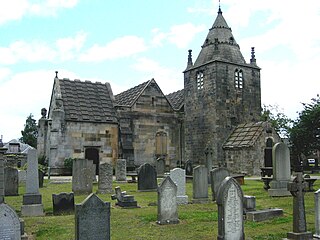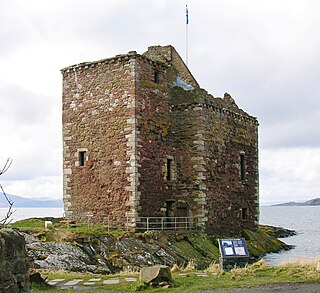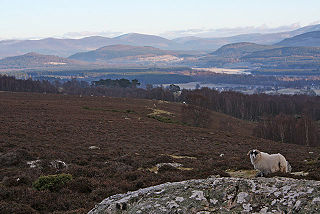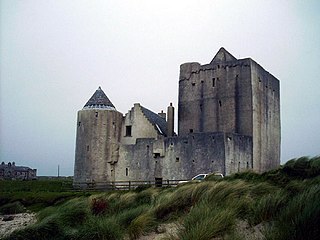
The Castle of Mey is located in Caithness, on the north coast of Scotland, about 6 miles (10 km) west of John o' Groats. In fine weather there are views from the castle north to the Orkney Islands.

The Union Canal, full name the Edinburgh and Glasgow Union Canal, is a canal in Scotland, running from Falkirk to Edinburgh, constructed to bring minerals, especially coal, to the capital. It was opened in 1822 and was initially successful, but the construction of railways, particularly the Edinburgh and Glasgow Railway, which opened in 1842, diminished its value as a transport medium. It fell into slow commercial decline and was closed to commercial traffic in 1933. It was officially closed in 1965. The canal is listed as three individual scheduled monuments by Historic Scotland according to the three former counties, Midlothian, West Lothian and Stirlingshire, through which it flows.

Corstorphine is an area of the Scottish capital city of Edinburgh. Formerly a separate village and parish to the west of Edinburgh, it is now a suburb of the city, having been formally incorporated into it in 1920.

Portencross Castle, also known historically as Portincross Castle, is situated in Portencross, on the west coast of Scotland, about 3 km from West Kilbride. The site has been fortified since the 11th Century. The present tower castle is thought to date from the mid-14th Century and later. It remained in use until it was unroofed by a great storm in 1739 and gradually became ruinous. The castle was designated as a scheduled ancient monument in 1955.

Callendar House is a mansion set within the grounds of Callendar Park in Falkirk, central Scotland. During the 19th century, it was redesigned and extended in the style of a French Renaissance château fused with elements of Scottish baronial architecture. However, the core of the building is a 14th-century tower house.

Blackness is a small village and harbour at Blackness Bay, an inlet of the Firth of Forth in Scotland. It lies 3.4 mi (5.5 km) east-southeast of Bo'ness, 5.0 mi (8.0 km) west-northwest of South Queensferry and 3.8 mi (6.1 km) north-east of Linlithgow, within the council area of Falkirk. It was formerly part of the historic county of West Lothian.

The Falkirk Steeple is a landmark which dominates the skyline of Falkirk in central Scotland. The present structure on the High Street was built in 1814, and replaced an earlier steeple dating from the late 17th century, which itself replaced a still earlier structure. The Falkirk Steeple is protected as a category A listed building. A stylised image of the steeple appears on the crest of Falkirk Football Club.

The Forresters are an ancient and noble clan of the Scottish Lowlands.

Amhuinnsuidhe Castle is a large 19th-century private country house on Harris, one of the Western Isles of Scotland. It was designated as a Category A listed building in 1971 and is now operated as a hotel and shooting estate.

Torwood is a small village located 2 miles (3.2 km) north-northwest of Larbert, 4 miles (6.4 km) north-west of Falkirk and 6 miles (9.7 km) south-southeast of Stirling. Torwood lies within the Falkirk Council area of Scotland. The population recorded in the 2011 UK Census was 245.

Bavelaw Castle is a historic house in the City of Edinburgh Council area, Scotland. It is north of Hare Hill in the Pentland Hills, four miles west of Penicuik, and two miles south of Balerno, above Threipmuir Reservoir. It was designated as a Category A listed building in 1971.

Dunachton is an estate on the north-west shore of Loch Insh in Badenoch and Strathspey, in the Highlands of Scotland. It occupies land immediately to the north of the A9 road and General Wade's Military Road.

Breachacha Castle is either of two structures on the shore of Loch Breachacha, on the Inner Hebridean island of Coll, Scotland. The earlier is a 15th-century tower house that was a stronghold of the Macleans of Coll, the island having been granted to John Maclean in 1431. This castle was superseded by a new dwelling in 1750 but continued to be occupied for a time, falling into a ruinous state only in the mid-19th century. Although work was performed in the 1930s to prevent further dilapidation, the castle was restored to livable condition only in the 1960s, by Nicholas MacLean-Bristol and his wife Lavinia. It is a Category A listed building.

Sorn Castle is located by the River Ayr just outside the village of Sorn in East Ayrshire, Scotland. The castle comprises a medieval tower house, which was extended over the years, and remodelled in the Scots Baronial style by David Bryce in the 1860s. The castle is protected as a category A listed building.

Elphinstone Tower, also known as Dunmore Tower or Airth Tower, is a ruined tower house on the Dunmore Estate in central Scotland. It is located 1.5 kilometres (0.93 mi) north-west of Airth and 9 kilometres (5.6 mi) east of Stirling in the Falkirk council area. The 16th-century ruin is protected as a category C(S) listed building.

Blackcraig Castle is a Baronial mansion house dating from 1856 in Perthshire, Scotland, close to the towns of Ballintuim and Blairgowrie on the banks of the River Ardle. It was built in 1856 by Patrick Allan Fraser, a prominent Scottish artist and architect, and is designated as a Class B-listed building, with its walled garden A-listed. It has undergone extensive renovations/modernisation in recent years to return it to its full former glory and remains one of the finest examples of Baronial architecture in Scotland.
David Seton of Parbroath was a Scottish courtier and administrator.

Mauldslie Castle, part of the Mauldslie Estate, was located in Dalserf, South Lanarkshire, Scotland.

















